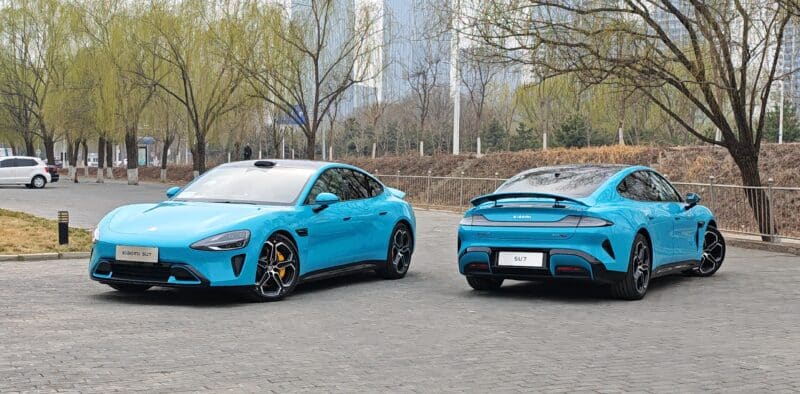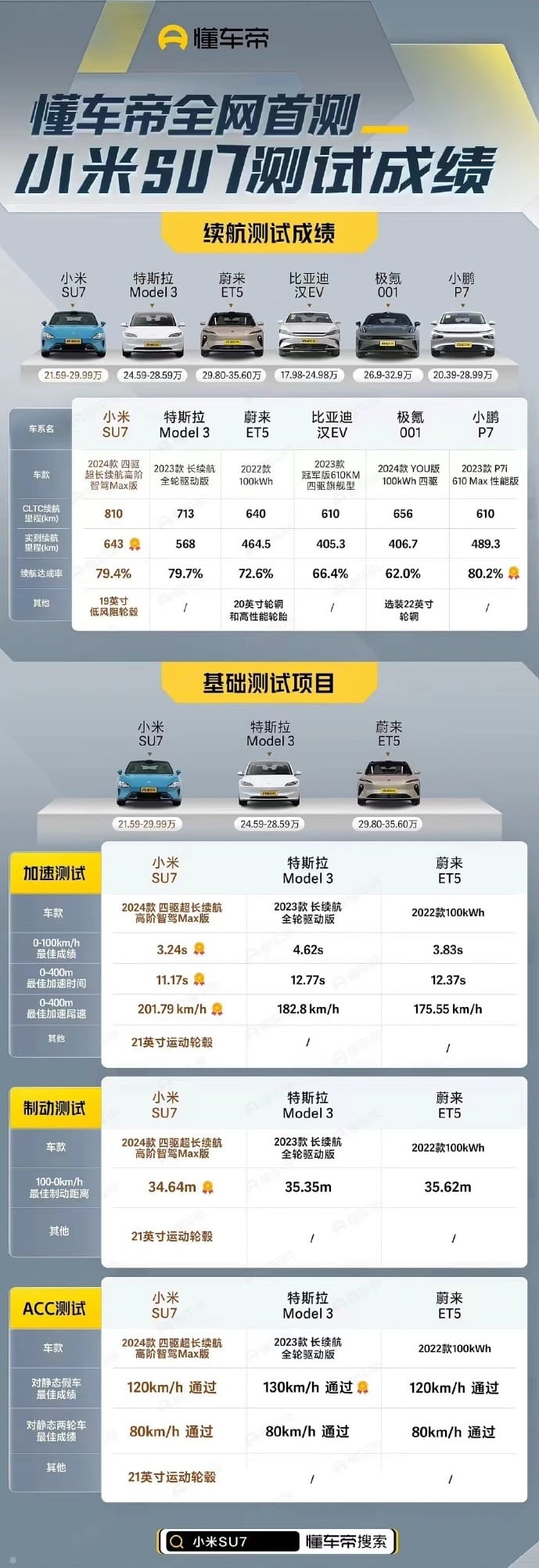Automotive journalists from the Chinese outlet Dongchendi tested the Xiaomi SU7 and compared its results with those of other electric sedans. The SU7’s official CLTC range is 800 km, and it reached a 643 km value during the road testing.
The top trim level of the Tesla Model 3 AWD Long Range (Highland) has an official range of 713 km under CLTC (China Light-Duty Vehicle Test Cycle) conditions. It reached 568 km during the test, 79.7% of the official value.
Nio ET5 2022, with a 100 kWh battery, has a CLTC range of 640 km and reached 455 km during the test, which is 72.6% of the official value. In March, Nio launched the 2024 facelift of its mid-size sedan; the one tested was the 2022 version.

The best result was Xpeng P7 in the updated 2023 P7i version, which reached 80.2% in the real road tests. The CLTC range is 610 km, and the tested value was 489 km.
Speed tests revealed that the SU7 was a clear winner, as Xiaomi’s first EV beat the Tesla Model 3 and the Nio ET5. In the 0-100km/h acceleration, the SU7 sprinted in 3.24 seconds, the Nio ET5 followed in 3.83 seconds, and the new Tesla Model 3 finished third in 4.62 seconds.
In the quarter-mile (400 m) drag race, SU7 won with 11.17 seconds, followed by Nio ET5 with 12.37 seconds and Tesla Model 3 with 12.77 seconds. Xiaomi also reached a tail speed of 201.79 km/h.
The Xiaomi SU7 is cheaper than the Tesla Model 3 by 30,000 yuan (4,100 SD) and the Nio ET5 by 82,100 yuan (11,500 USD).
Speed test results:
| Xiaomi SU7 | Tesla Model 3 | Nio ET5 | |
| Trim | 2024 Max | Highland | 2022 100 kWh |
| 0-100 km/h | 3.24 s | 4.62 s | 3.83 s |
| 0-400 m | 11.17 s | 12.77 s | 12.37 s |
| 0-400 m tail speed | 201.79 km/h | 182.8 km/h | 175.55 km/h |
Range test results:
| Xiaomi SU7 | M3 | ET5 | BYD Han EV | Zeekr 001 | Xpeng P7 | |
| Trim | Max | Highland | 2022 100 kWh | 2023 610 | 2024 You 100kWh | 2023 P7i 610Max |
| CLTC | 810 km | 713 km | 640 km | 610 km | 656 km | 610 km |
| Tested | 643 km | 568 km | 455 km | 405 km | 407 km | 489 km |
| Rate | 79.4% | 79.7% | 72.6% | 66.4% | 62.0% | 80.2% |
Price range comparison:
| Model/Price | Yuan | USD |
| Xiaomi SU7 | 215,900 – 299,900 | 29,900 – 41,500 USD |
| Tesla Model 3 | 245,900 – 285,900 | 34,050 – 39,600 USD |
| Nio ET5 | 298,00 – 356,000 | 41,300 – 49,300 USD |
| BYD Han | 179,800 – 249,800 | 24,900 – 34,600 USD |
| Zeekr 001 | 269,000 – 329,00 | 37,300 – 45,600 USD |
| Xpeng P7 | 203,900 – 289,900 | 28,250 – 40,150 USD |




